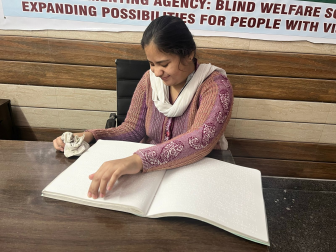Living independently is a goal for many, and it’s absolutely possible for visually impaired individuals with the right adjustments. A key part of living independently is ensuring that your home is a safe, accessible, and comfortable space where you can navigate and manage daily activities with ease. Adapting your living environment with simple changes and technology can empower you to maintain autonomy and lead an active, fulfilling life. This blog explores practical tips for adapting your home for comfort and accessibility, allowing visually impaired individuals to live confidently and independently.
The first step toward creating an accessible home is to evaluate the space and identify potential obstacles. It's important to consider how easily you can move through different areas and whether furniture, lighting, or other objects present challenges.
Proper lighting is crucial for visually impaired individuals. Even if full vision is not possible, contrast and adequate lighting can help with distinguishing objects, reading, and maintaining orientation in a room.
Technology can play a huge role in making a home more accessible. There are various devices and tools available to assist with daily tasks, providing independence and ease.
The kitchen is an area where safety and accessibility are especially important. With a few adjustments, you can make cooking and meal preparation both safe and efficient.
The bathroom is an essential area to adapt for safety and comfort. Ensuring that your bathroom is accessible allows for independent personal care.
Furniture can also be adapted for greater comfort and accessibility. Choosing the right furniture and adding tactile elements can make all the difference.
One of the biggest keys to independent living is organization. A well-organized home, where everything has its place, enables you to complete daily tasks efficiently and safely.
Security is crucial for any home. For individuals with visual impairments, a few simple steps can ensure that your living space is safe and secure.
Independence is not only about managing physical spaces but also about maintaining emotional and social well-being.
Adapting your home for comfort and accessibility is a powerful step toward living independently as a visually impaired individual. By incorporating simple yet effective changes—such as ensuring clear pathways, using assistive technology, organizing efficiently, and creating an accessible kitchen and bathroom—you can make your living space both safe and enjoyable. Independence doesn’t mean doing everything alone, but rather having the tools, systems, and confidence to manage your environment and thrive in your daily life. With these changes, you can live independently, comfortably, and confidently.
By contributing to our feature donation campaigns, you are not just supporting us,
you are fostering independence, education, and accessibility for the people with blindness.
We are providing free shelter, food and educational support to the abandoned visually impaired girls residing at BWS.
₹1146061
raised of ₹2000000 Goal
57%
2 Days left
572 Supporters
Maa and Papa weren’t the happiest when I was born. They thought I was a burden to them.
₹768833
raised of ₹2000000 Goal
38%
2 Days left
589 Supporters
The Walking Canes have proved a useful tool to millions of blind people in navigating their environments with confidence and ease.
At our organization, we provide a nurturing environment for visually impaired girls, helping them lead fulfilling lives despite their challenges.
The following stories highlight the transformative journey of these remarkable individuals within our organization.

Hailing from Delhi, Sneha came to Blind Welfare Society in July 2023.
.jpeg)
Hailing from a small village of Gwalior district, Madhya Pradesh, Archana came to Blind Welfare Society in July 2023

Chhavi’s journey is a testament to the transformative power of education and the invaluable support provided by the Blind Welfare Society.